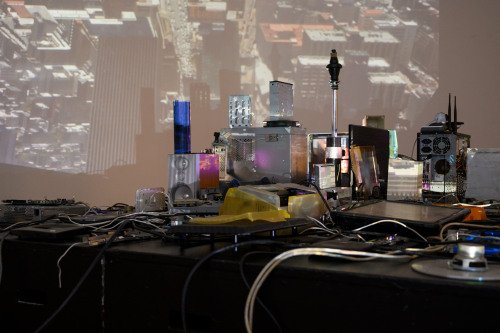Homunculi of the Digital City
Employing the media of video and installation, Homunculi of the digital city explores what it means to live in a digitally-mediated city. In my work, I personify both the city and city dwellers as cyborgian characters, by drawing on Donna Haraway’s definition of the cyborg. I expand my personification further by employing the Homunculus from Johann Wolfgang von Goethe’s Faust II (1950, originally published in 1832). I utilise Matthew Gandy, Ingrid Hoelzl and Rémi Marie’s discussions around the broader city so to consider the material and immaterial elements that constitute it. The screens that populate contemporary cities embody both these elements: they are physical objects that perform invisible data, in the vein of Boris Groĭs’ analogy of an image file being analogous to a piece of music that needs to be performed in order to be sensible. By drawing on these frameworks, I position the city as a high density of screens that are physically ubiquitous, often a prosthetic, and function as a gateway to the immaterial elements of the city.
Digital City Performance. 2019-2020
Excerpts from Donna Haraway’s “A Cyborg Manifesto”
“A cyborg is a cybernetic organism, a hybrid of machine and organism, a creature of social
reality as well as a creature of fiction.” (Haraway, 2016: 5)
“By the late twentieth century, our time, a mythic time, we are all chimeras, theorized and
fabricated hybrids of machine and organism—in short, cyborgs.” (2016: 7)
“It is also an effort to contribute to socialist-feminist culture and theory in a postmodernist,
non-naturalist mode and in the utopian tradition of imagining a world without gender, which
is perhaps a world without genesis, but maybe also a world without end.” (2016: 7)
“In a sense, the cyborg has no origin story in the Western sense—a ‘final’ irony since the
cyborg is also the awful apocalyptic telos of the ‘West’s’ escalating dominations of abstract
individuation, an ultimate self untied at last from all dependency, a man in space.” (2016: 8)
“The cyborg is resolutely committed to partiality, irony, intimacy, and perversity. It is
oppositional, utopian, and completely without innocence. No longer structured by the
polarity of public and private, the cyborg defines a technological polis based partly on a
revolution of social relations in the oikos, the household. Nature and culture are reworked;
the one can no longer be the resource for appropriation or incorporation by the other. The
relationships for forming wholes from parts, including those of polarity and hierarchical
domination, are at issue in the cyborg world. Unlike the hopes of Frankenstein’s monster, the
cyborg does not expect its father to save it through a restoration of the garden—that is,
through the fabrication of a heterosexual mate, through its completion in a finished whole, a
city and cosmos.” (2016: 9)
“The main trouble with cyborgs, of course, is that they are the illegitimate offspring of
militarism and patriarchal capitalism, not to mention state socialism. But illegitimate
offspring are often exceedingly unfaithful to their origins. Their fathers, after all, are
inessential.” (2016: 9-10)
“By the late twentieth century in U.S. scientific culture, the boundary between human and
animal is thoroughly breached.” (2016: 10)
“Biological-determinist ideology is only one position opened up in scientific culture for
arguing the meanings of human animality. There is much room for radical political people to
contest the meanings of the breached boundary. The cyborg appears in myth precisely
where the boundary between human and animal is transgressed. Far from signaling a
walling off of people from other living beings, cyborgs signal disturbingly and pleasurably
tight coupling.” (2016: 10-11)
“The second leaky distinction is between animal–human (organism) and machine. Pre-
cybernetic machines could be haunted; there was always the specter of the ghost in the
machine. This dualism structured the dialogue between materialism and idealism that was
settled by a dialectical progeny, called spirit or history, according to taste. But basically
machines were not self-moving, self-designing, autonomous. They could not achieve man’s
dream, only mock it. They were not man, an author to himself, but only a caricature of that
masculinist reproductive dream. To think they were otherwise was paranoid. Now we are not
so sure. Late twentieth-century machines have made thoroughly ambiguous the difference
between natural and artificial, mind and body, self-developing and externally designed, and
many other distinctions that used to apply to organisms and machines. Our machines are
disturbingly lively, and we ourselves frighteningly inert.” (2016: 10)
“Modern machines are quintessentially microelectronic devices: they are everywhere and
they are invisible. Modern machinery is an irreverent upstart god, mocking the Father’s
ubiquity and spirituality. The silicon chip is a surface for writing; it is etched in molecular
scales disturbed only by atomic noise, the ultimate interference for nuclear scores.” (2016:
12-13)
“Our best machines are made of sunshine; they are all light and clean because they are
nothing but signals, electromagnetic waves, a section of a spectrum, and these machines
are eminently portable, mobile—a matter of immense human pain in Detroit and Singapore.
People are nowhere near so fluid, being both material and opaque. Cyborgs are ether,
quintessence.” (2016: 13)
Source:
Haraway, D.J. 2016. Manifestly Haraway. Minneapolis: University of Minnesota Press. Available:
http://ebookcentral.proquest.com/lib/warw/detail.action?docID=4392065. [2018, April 5].


